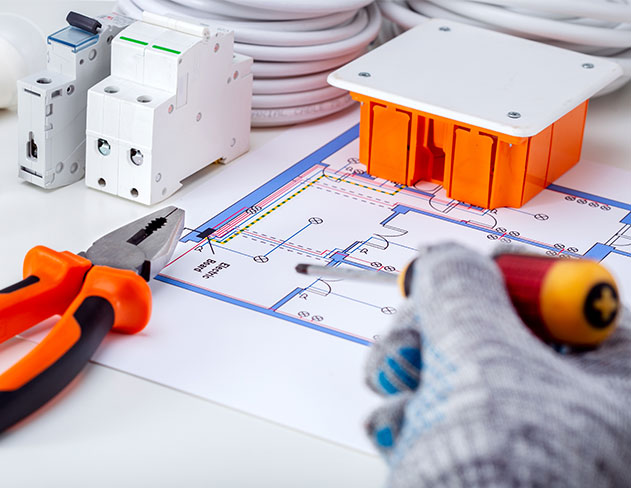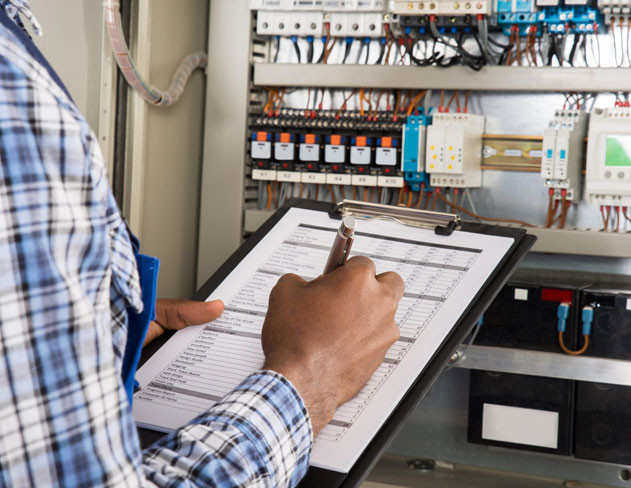Electrical safety is absolutely critical in school environments. EICRs are a legal requirement for all schools in order to protect students, teachers, and staff.
This comprehensive guide will explain everything you need to know about EICR compliance and best practices for electrical safety in schools.
Understanding Electrical Testing (EICR) in Schools
Why is Electrical Testing Necessary in Schools?
There are several crucial reasons why electrical testing is mandatory for all educational institutions:
- Legal Compliance: EICR testing is required by law in schools as part of the Electricity at Work Regulations 1989. Failing to comply can result in heavy penalties.
- Student & Staff Safety: Faulty electrics can lead to electric shocks, fires, and injuries. Testing minimises these risks in busy school environments.
- Identify Faults: EICR will find safety issues such as broken wiring, overloaded circuits, and faulty RCDs. These faults may be invisible without proper testing.
- Preventative Maintenance: Testing determines if preventative maintenance is needed to keep electrical systems working safely.
- Insurance Requirements: Most insurance policies mandate periodic EICR testing. It also provides proof of safety compliance if accidents occur.
Electrical testing is fundamental to a school’s safety, regulatory, and legal responsibilities. It provides invaluable protection for students, teachers, and faculty on the premises. For more details, refer to The Complete Guide To Commercial EICR.
How is Electrical Testing Conducted in Schools?
EICR testing in schools generally involves the following methodology tailored to educational settings:
- The electrician will carry out a full visual inspection of all visible wiring and electrical components. This includes inside distribution boards, plug sockets, and light fixtures.
- Insulation resistance testing is done to measure insulation integrity and check for potential damage.
- Earth continuity testing confirms effective earthing in all circuits to prevent electric shocks.
- Polarity testing makes sure all devices are wired correctly with proper live and neutral connections.
- RCD testing checks that the life-saving residual current devices work to isolate faults.
- Load testing verifies circuits are not overloaded and wiring can handle required electrical loads.
- Fixed appliance testing may be conducted on built-in appliances.
- Once testing is complete, the schools receive certification along with a detailed EICR inspection report.
Proper scheduling around school activities is crucial when coordinating electrical testing. The electrician should also ensure minimal disruption to lessons and operations during the process.
Understanding the EICR Procedure and getting your head round the report is essential. Read more about Understanding the EICR Procedure tailored to educational settings.
Legal and Regulatory Framework for Schools
National Regulations and Standards for Schools
There are a number of key regulations and standards surrounding electrical safety and testing that apply to UK schools:
- The Electricity at Work Regulations 1989 mandate that electrical systems must be maintained to prevent danger. EICR testing helps schools comply.
- BS 7671 Wiring Regulations (18th Edition) is the UK standard for electrical installations. Schools must adhere to its safety guidelines.
- The school environment is classified as a “special location” under BS 7671. This requires additional safety precautions.
- For boarding schools, BS 7671 states electrical rooms must be marked “Access only permitted to authorised persons”.
- The UK Association of British Insurers recommends schools have electrical testing every 5 years.
- The national Standard for Electrical Testing (SET) outlines schools’ testing process.
Compliance with these standards ensures schools meet their duty of care for safe electrics. The regulations also provide legal protection if accidents occur on school grounds due to electricity.
Local Authority Requirements for Schools
In addition to national standards, Local Education Authorities (LEAs) often impose electrical safety rules that schools must follow.
- LEAs may require more frequent testing than the 5 years in national standards. Annual or 2-yearly testing is common.
- They may request copies of electrical test certificates and reports to verify safety compliance.
- LEAs procure contractors on approved lists to ensure competent electricians handle school testing.
- For academy schools, LEAs delegate responsibility for arranging testing, but still monitor for compliance.
- LEAs can conduct site inspections and audits to check electrics, and require any remedial actions identified.
Adhering to LEA requirements is vital for schools to continue receiving support and funding. It also helps LEAs fulfil their health and safety obligations.
Compliance and Enforcement in Schools
The Health and Safety Executive (HSE) is the national body that regulates electrical safety compliance in UK schools. Consequences for non-compliance include:
- The HSE can prosecute schools with penalties up to £20,000 per offence.
- School governors can be personally prosecuted for breach of their health and safety responsibilities.
- Electrical contractors can also be prosecuted for failure to issue test certificates.
- Insurance policies may become invalidated, leaving schools unprotected.
- Civil lawsuits for negligence may arise if electrical faults cause injuries.
- Non-compliant schools may face additional HSE inspections and mandatory audits.
- Reputational damage can occur along with negative publicity.
These substantial penalties and risks highlight why regulatory electrical safety compliance is paramount for schools.
Implementing Electrical Testing in Schools
Selecting a Qualified Electrician for Schools
Choosing an experienced, professional electrician is key to reliable testing and safety compliance in schools. Important factors include:
- They must be registered with a government-approved scheme such as NICEIC or NAPIT to ensure proper qualifications and training.
- Knowledge of the educational environment and regulations specific to schools is essential.
- Experience working in school buildings, both modern and older sites, is advantageous.
- They should have all necessary equipment and public liability insurance cover.
- Multiple electricians may be needed for timely and efficient testing for larger school sites.
- Cost is a consideration, and you should choose a supplier with experience, 5 star reviews and up front costs, like Hexo. Learn more about what factors affect the cost of an EICR.
- Checking references or recommendations from other schools can provide added confidence.
- Ensure they will provide detailed reports tailored to the compliance needs of educational institutions.
Taking time to select the right electrician ultimately protects the school and assures that testing will be conducted competently.
Scheduling and Planning in School Settings
Proper scheduling is crucial, and understanding How Long Does An EICR Test Take can help in planning the process. Arranging EICR inspections requires advance coordination to minimise disruption for schools:
- Testing should ideally be scheduled during holidays when buildings are unoccupied.
- If testing during term time, electrical checks should occur outside teaching hours or when classrooms are not in use.
- Testing heavily used areas like kitchens may need to be done outside meal preparation times.
- The electrician should work closely with the facilities manager to sequence the testing appropriately around the school’s activities.
- Adequate notice to staff and parents/guardians is advisable before testing.
- Ensure sufficient time is allowed depending on the size and complexity of the school buildings and electrical system.
- Allow quick resolution of any urgent risks identified, before areas are put back into use.
Careful planning prevents interference in school operations while enabling necessary testing for safety.
Understanding the Report and Its Implications for Schools
The EICR inspection report is hugely important for addressing risks and proving compliance:
- It logs a complete breakdown of all tested circuits, providing details of any damage, wear and tear, or configuration issues.
- Codes classify the severity of each observed defect (C1 to C3) based on urgency and potential danger.
- Recommendations are made to correct identified problems, with coding to highlight high priority fixes.
- Failure to address critical “C1” coded risks could result in enforcement action if inspected.
- Schools rely on the report findings to budget and plan required electrical remediation work.
- The report must be retained as evidence of regulatory compliance and insurance obligations.
- Results enable facilities managers to target maintenance for safety and develop future testing schedules.
Careful review of the formal report is imperative for schools to act on necessary remedial actions and demonstrate compliance. It’s crucial to know What Happens If Your EICR Report Returns an Unsatisfactory Result? to take appropriate actions.
Post-Testing Actions and Maintenance in Schools
Once EICR testing is complete, schools must take the appropriate follow-up actions:
- Any identified high-risk or urgent defects should be fixed immediately, using a qualified electrician.
- Other advisable remedial work should be scheduled promptly as well.
- Schools must retain copies of electrical reports and certifications indefinitely under regulations.
- Test reports should be shared with the LEA or other governing bodies as requested.
- Results may warrant a reassessment of general electrical safety policies and staff training.
- Future testing timeframes can be confirmed based on the electrician recommendations.
- Budgeting for ongoing testing and electrical maintenance based on the findings is prudent.
- Regular visual inspections of distribution boards, wiring, and appliances should complement periodic testing.
- A proper record-keeping system for electrical work and testing certificates is essential.
- Facilities managers should stay up to date on evolving electrical regulations affecting schools.
If electrical defects are found during an EICR, then remedial works are needed to fix the problems and make the installation safe. Learn more about Remedial Works offered by Hexo Electrical Testing.
Future Trends and Innovations in School Electrical Testing
Technological Advancements in School EICR Testing
Innovations in electrical testing technology are enhancing efficiency and safety assurance in schools:
- Digital apps allow easier recording of test results and tagging of locations that speeds reporting.
- Data analytics help predict where electrical faults may occur and optimise maintenance.
- Infrared thermography and drone technology are being used for remote visual inspections.
- Artificial intelligence supports more accurate analysis and classification of observed risks.
- Online portals give facilities managers quick access to past test records and certificates.
- Testing devices keep improving to expand the types of faults that can be identified proactively.
Embracing these cutting-edge testing technologies will strengthen electrical safety capabilities for schools in the future.
Evolving Regulations and Standards for Schools
Industry experts anticipate further changes ahead to the electrical compliance landscape for schools:
- Standards will likely adapt to new technologies such as solar, EV charging, and batteries on campus.
- Stricter grade separation requirements for commercial and lighting circuits may emerge.
- Testing could expand to include emergency lighting systems and lightning protection.
- Mandatory safety training for on-site electrical duty holders may be introduced.
- Updated record-keeping and digital retention rules for test reports are probable.
- Minimum qualification requirements for school electricians may increase over time.
Keeping abreast of changing rules through trade bodies and regulators will ensure schools stay compliant.
Conclusion Electrical Testing in Schools: Ultimate Guide to EICR Compliance & Safety
Electrical safety is a crucial yet often overlooked facet of managing school facilities. The potentially devastating risks posed by faulty electrics demand rigorous focus on periodic EICR testing. While the process involves effort and investment, the payoff is immense in preventing harm to students, staff, and the entire school community.
Going beyond mere compliance to proactively embrace testing best practices, innovations, and continuous learning is key to fostering a culture of electrical safety across the education sector. The safety of children relies first and foremost on the integrity of school electrics.

